How To Tie Knots and Hitches
Technically, a knot forms a loop or noose, fastens two ends of the
same cord, or creates a "stopper" in the end of the rope. A bend joins two free
ends together, and a hitch grips a shaft or another rope. Rope, cordage and webbing is
strongest when loaded in a strait line. When you bend the rope or web to create a knot,
the strength of the rope is reduced.
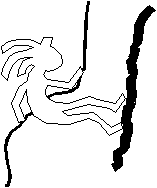 Knot Strenth
Knot Strenth
| No Knot |
100% |
| Figure Eight |
70-75% |
| Double Bowline |
70-75% |
| Double Fisherman's |
65-70% |
| Water Knot |
60-70% |
| Overhand Knot |
60-70% |
| Clove Hitch |
60-70% |
| Square Knot |
45% |
 Overhand Knot
Overhand Knot
Probably the simplest knot in existence. Usually used as a stopper knot, but a double
overhand is preferable.
 Double Overhand Knot
Double Overhand Knot
Better as a stopper knot than the Overhand, as it is less likely to pull through.
 Tautline Hitch
Tautline Hitch
This knot is the standard for tying out tents in rough weather. This knot will slip up and down the
rope by hand, but not by tention. You can also fix a draw-string sack with this knot.

 Bowline
Bowline
The bowline is easy to adjust and untie. Beware, though, that if tied incorrectly in
can be unsafe. You should really tie a stopper knot in the loop with the loose end to
prevent it from pulling through.
 Yosemite Bowline
Yosemite Bowline
This is a variant of the basic bowline which gets around the problem of the
knot loosening itself by taking the end of the rope and threading it back
through the knot. This is a neat alternative to using a half-hitch to secure the
end of the rope and the resulting knot has the strength of a figure of eight.
 Bowline on the bight
Bowline on the bight
This is another double loop knot suitable for rigging Y-belays. It has the advantage
that is is a bit less bulky than the figure-of-eight on the bight.
 Fisherman's Knot
Fisherman's Knot
Probably the simplest knot for joining two ends of rope. Consists of two overhand
knots.
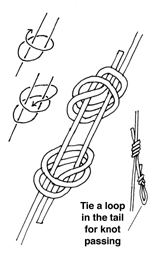 Double Fisherman's Knot
Double Fisherman's Knot
Better than the Fisherman's Knot, this uses two double overhand knots. Good knot, as it
can be difficult to untie. Check regularly for the loose ends getting shorter, and if so,
re-tie. Tighten with body weight.
 Overhand Loop
Overhand Loop
This is the simplest way to create a closed loop in the middle of a rope. Difficult to
untie after loading.
 Alpine Butterfly
Alpine Butterfly
A good knot for rebelays or for tying rub points out of a rope. Its main
advantage is that the two strands of rope emerging from the knot
are at 180 degrees to one another rather than emerging in the same direction
as in a figure-of-eight for example. This makes it a good mid-rope knot and
good for rebelays because it has greater strength than a figure-of-eight if the rebelay fails.
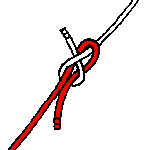 Sheet Bend
Sheet Bend
Occasionaly used to join the ends of ropes, may be adjusted easily, but can also come
undone easily.
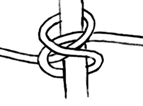 Constrictor Knot
Constrictor Knot
A new knot useful to cavers and climbers was invented early this century
by Clarence Ashley himself. He calls it "the constrictor knot". It is enormously
resistant to coming undone. Ashley claims it can be used in a pinch as a radiator
hose-clamp.
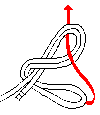
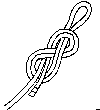 Figure-of-Eight
Figure-of-Eight
The Figure-of-Eight knot is probably the most useful of all climbing knots. It is easy
to tie, easy to undo after a load has been applied, and puts the least stress on the rope
when tied tight. It can be tied anywhere in the rope, but if it's near the end, it should
be secured with a stopper knot to prevent the knot from un-doing itself.
There are generally two methods used to tie a figure of eight knot. The first method is
used when a piece of equipment is clipped into the loop, the second when the knot is used
to tie into something, for example, a climbing harness.
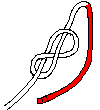

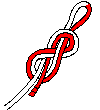 Figure-of-Eight Re-Threaded
Figure-of-Eight Re-Threaded
The above re-threaded method is usually used to tie into a harness, and is just a case
of making a figure-of-eight on the single rope, looping through the harness, and following
the knot back through itself.
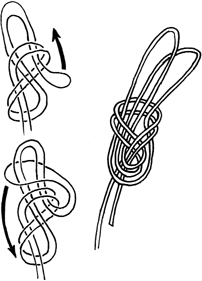 Double Figure-of-Eight on the Bight
Double Figure-of-Eight on the Bight
This double loop knot is most commonly used for rigging Y-belays. The nature
of the knot means that it is reasonably easy to adjust the loops by moving
rope from one of the loops to the other.
 Figure-of-Nine
Figure-of-Nine
The figure-of-nine knot can be used as an alternative to the figure-of-eight.
It is very similar to a figure-of-eight with just an extra turn before finishing the
knot. It is a little bulkier than the figure-of-eight but has greater strength.
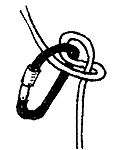 Italian/Munter Hitch
Italian/Munter Hitch
An excellent self-reversing friction knot suitable for belaying people
when climbing or using a ladder. It can also be used for abseiling and gives a smoother ride than
a stitcht plate (IMHO).
This one is worth learning for all those occasions when you
forget your Stitcht plate or descender.
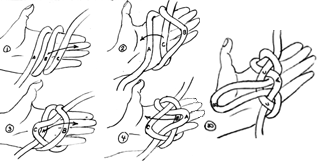 Farmers hitch
Farmers hitch
This knot is excellent for tying in the middle of a climbing rope, for rebelays, for lashings of
many kinds -- anyplace a loop that leads fair both ways in wanted. The method for putting it in
is simplicity itself:
Take three turns of the rope round your hand, then:
1. Move center part (b) over right part.
2. Move new center part (c) over left part.
3. Move new center part (a) over right part.
4. Pull new center part (b) up to form the loop
5. For most satisfying results, remove hand before fairing or loading knot.
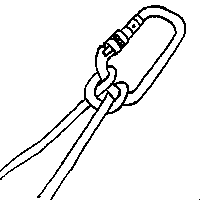
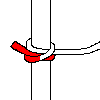 Clove Hitch
Clove Hitch
The clove hitch is easily adjusted when place, but is not a particularly strong knot.
If one side of the knot is to be loaded, place the diagonal underneath. If both sides are
to be loaded, place the diagonal at the top. Tighten before loading, as it may run if
loaded when loose.
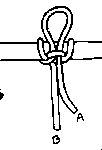

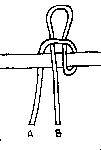 Highwayman's Hitch
Highwayman's Hitch
This knot can bear one's weight on one strand of the rope and can be untied by just
pulling on the other strand. End 'B' is the load-bearing end. NOT RECOMMENDED for
climbing, but excellent for robbing stagecoaches, when you want to get away quick with
your rope.
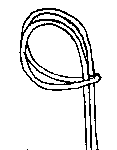 Girth Hitch/Lark's Foot
Girth Hitch/Lark's Foot
Quick knot, but weak. Best avoided.
Ascending Knots
Five ascending knots are shown in all, each have their advantages and disadvantages.
Try them all out, and see which you prefer.
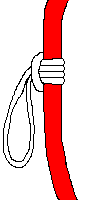 Prusik Loop
Prusik Loop
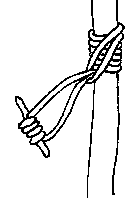
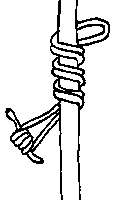 The Kleimheist
The Kleimheist
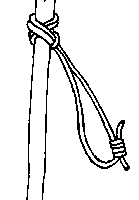
 The Hedden Knot, also known as Kreutzklem
The Hedden Knot, also known as Kreutzklem
First published in 1960 in Summit Magazine. In 1964, the name Kreutzklem was attached
to it by someone in the German mountain troops who was shown it by an officer serving in
the US Air Force. The Kreutzklem name (cross-clamp) was applied because the original
inventor (Chet Hedden) got lost somewhere along the way when it was shown to different
people in Europe.

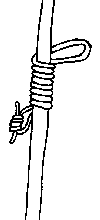 The French Prusik
The French Prusik
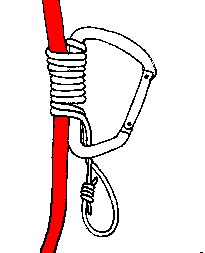 The Bachmann
The Bachmann

 Overhand Knot
Overhand Knot
 Double Overhand Knot
Double Overhand Knot
 Tautline Hitch
Tautline Hitch

 Bowline
Bowline
 Yosemite Bowline
Yosemite Bowline
 Bowline on the bight
Bowline on the bight
 Fisherman's Knot
Fisherman's Knot
 Double Fisherman's Knot
Double Fisherman's Knot
 Overhand Loop
Overhand Loop
 Alpine Butterfly
Alpine Butterfly
 Sheet Bend
Sheet Bend
 Constrictor Knot
Constrictor Knot

 Figure-of-Eight
Figure-of-Eight


 Figure-of-Eight Re-Threaded
Figure-of-Eight Re-Threaded
 Double Figure-of-Eight on the Bight
Double Figure-of-Eight on the Bight
 Figure-of-Nine
Figure-of-Nine
 Italian/Munter Hitch
Italian/Munter Hitch
 Farmers hitch
Farmers hitch

 Clove Hitch
Clove Hitch


 Highwayman's Hitch
Highwayman's Hitch
 Girth Hitch/Lark's Foot
Girth Hitch/Lark's Foot
 Prusik Loop
Prusik Loop

 The Kleimheist
The Kleimheist

 The Hedden Knot, also known as Kreutzklem
The Hedden Knot, also known as Kreutzklem

 The French Prusik
The French Prusik
 The Bachmann
The Bachmann